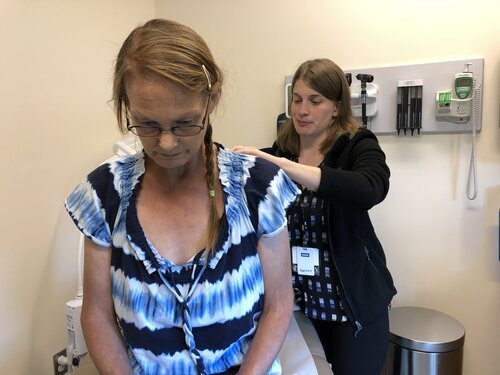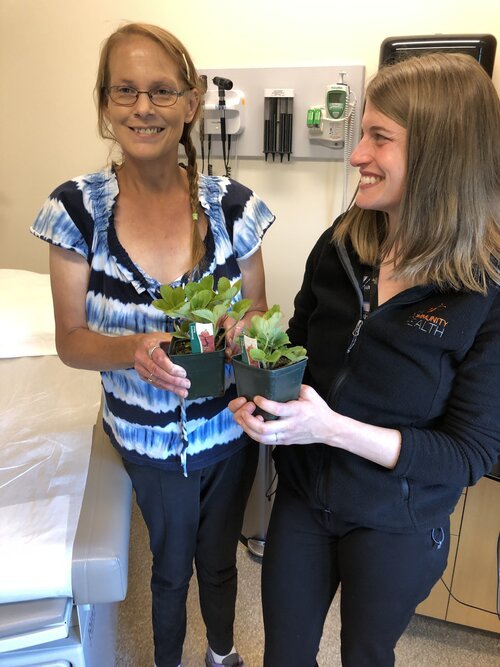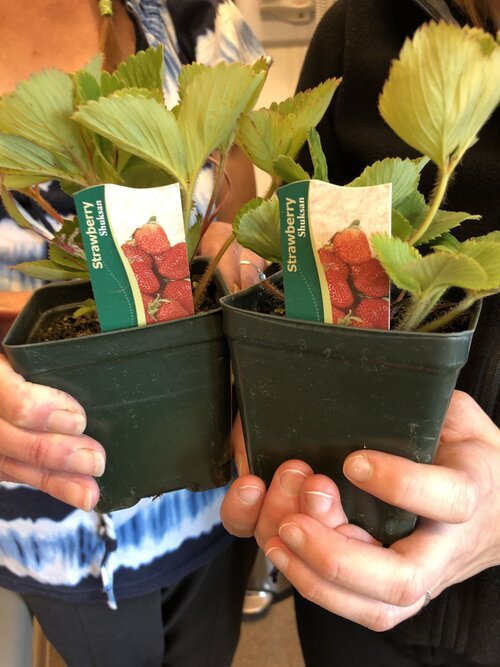The Art of Osteopathic Manipulation
Patient Kara Allphin finds pain relief and builds trust in an alternative treatment, an OCH service offered by Samantha Carolla, D.O.
For many people, walking without a cane is no big deal. But when Kara Allphin, who has struggled with osteoarthritis for years, came to One Community Health (OCH) for a doctor’s appointment in July 2019, the lack of cane was near cause for celebration. At the very least, it was the first time Samantha Carolla, D.O., had seen her patient not use one.
“She’s definitely made improvements with osteopathic manipulation therapy—or, OMT,” says Dr. Carolla, who provides this unique medical service out of the health center in The Dalles. “With each visit, she’s increased her functionality, and she tells me she can do activities she likes to do—like gardening—more often.”
And that says a lot, considering Kara first came to OCH after experiencing sudden, extreme pain while doing that very activity.
“I was just out in my yard gardening and something snapped in my shoulder—it really hurt,” says Kara. “I went to see my primary care provider at One Community Health, Dr. Allison Hoffman, and after three or four visits with her, she referred me to her team member, Dr. Carolla, thinking it might be a muscle injury or torn rotator cuff.”
Kara is no stranger to pain. A patient with disabilities, she has severe nerve damage and bulging discs. She typically uses a walker and cane, sitting much of the time, however. Pain medication never helped, nor did acupuncture. So willing to try something new, Kara agreed to osteopathic manipulation therapy to address her musculoskeletal challenges while seeking specialized treatment for arthritis through a non-OCH provider.
Osteopathic manipulation therapy first requires a primary care provider visit, specifically at OCH, for an internal referral, plus prior authorization through the patient’s insurance. And as it’s one of many ways to treat pain, there are no guarantees for relief—but for Kara, it was certainly worth a try. Examples of the types of osteopathic manipulation she's been experiencing include cervical traction (release on the paraspinal muscles of the neck), myofascial release (“ironing” out tight muscles) and counterstring (relaxing tender points of overreactive muscles and nerves).
“Dr. Carolla told me she can’t fix arthritis, but she’s a miracle worker when it comes to my muscles—which are literally in knots when I come in to see her,” Kara says. “She does all this stretching and kneading, just like you’re kneading bread. She manipulates and coaxes them back out to where they need to be. From all the muscle pain, particularly on my right side, my right shoulder kind of sags some, and she helps me with exercises to align my shoulders. I instantly gained a sense of trust in her after my first visit. I was real honest with her about my pain, and I feel like she is my friend.”
Kara says that because the arthritis is still one of the root issues being addressed, the pain returns over time even after her manipulations. However, she does experience relief and this allows her to get back out in her garden, which she tends to like a work of art…changing it up year after year, even allowing it to go fallow sometimes, enabling regeneration and new life for the next growing season. This year, she’s been separating out her plants because they’ve been too clogged and “struggling to breath,” she says. Her tangled strawberry plants are not unlike the muscles Dr. Carolla has to sort out and separate during Kara’s visits. Her insurance plan only allows for a limited number of visits each year, however.
“What Dr. Carolla does, it’s art,” Kara says. “It really is…and I say this with all sincerity that I’ve gotten the best care I could imagine from both Dr. Carolla and Dr. Hoffman. Those two are the most awesome doctors I’ve ever seen. They’d go to bat for me, and there’s no lollygagging around with them. I look forward to my visits.”
Both providers look forward to seeing all their patients. Yet when someone like Kara comes into the health center, showing improvements like enjoying activities in life and letting go of the cane, Drs. Carolla and Hoffman reap the rewards of practicing medicine.
“It’s why we do what we do,” Dr. Carolla says. “What’s more, osteopathic manipulative therapy is one of many tools that can not only help manage pain but, more importantly, improve function and quality of life. I am grateful that we are able to offer this service to established patients like Kara and others at OCH by making it part of their treatment plan in conjunction with their primary care provider.”





